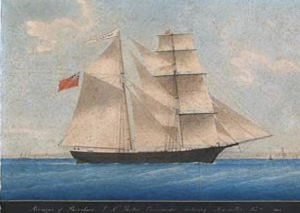
An 1861 painting of Amazon (later renamed Mary Celeste) by an unknown artist (perhaps Honore Pellegrin)
Ever since humankind created craft to fare the seas some 8,000 years ago, there have been stories of “ghost ships” – those craft appearing with nary a person aboard, with no evidence of what happened.
One such craft was the Mary Celeste, which gained notoriety because of a short story written in 1884 by Arthur Conan Doyle, who would later be known for his books about Sherlock Holmes. In the style of Orson Welles’ radio version of War of the Worlds, Doyle’s story was picked up by the public and believed to be true. Ever since, the Mary Celeste has been the subject of investigation, theory and speculation.
The facts
The few known facts have been derived from letters, logs and investigations of the time. Benjamin Spooner Briggs, who was master of three previous commands, purchased the Amazon at a salvage auction, with two partners, in New York. He refurbished the brigantine (or half-brig, depending on the source) and renamed it Mary Celeste. Briggs was a seasoned and respected mariner.
On Nov. 7, 1872, the ship departed Staten Island, after two days of being anchored there from New York due to heavy seas, bound for Genoa, Italy. The hold was loaded with 1,700 barrels of raw American alcohol. Onboard were Captain Briggs, his wife Sarah Elizabeth and their two-year-old daughter Sophia. Their seven-year-old son stayed ashore with his grandmother so he could attend school. The crew consisted of a captain, first officer, cook, and four German seamen. The brig was expected to pass through the Straits of Gibraltar on December 6, 1872, a short and uneventful journey. The last ship’s log entry was on November 25, Stating that the ship was six miles from (and within sight of) the island of Santa Maria, in the Azores. Briggs then changed course to head north of Santa Maria. The night before, the Mary Celeste was experiencing rough seas and winds of over 35 knots. The ship had sailed the last few hundred miles in a gale. Nonetheless, the log did not indicate any actual distress for the safety of ship and crew.
On Dec. 4, 1872, the brig Dei Gratia came upon the Mary Celeste. Captain Morehouse, the master of the Dei Gratia, was an old friend of Briggs’, and his ship had sailed out of New York eight days after the Mary Celeste. About 370 nautical miles east of Santa Maria, the Mary Celeste appeared to be adrift, and attempts to hail the crew failed, so the Dei Gratia pulled up beside her and half the crew boarded her and piloted her to Gibraltar as salvage.
The condition of the Mary Celeste was, in general, very seaworthy, but there were no people aboard at all. Some of the sails had been blown away, but the remaining ones were set properly and in good shape. Part of the main peak halyard had been broken off. Both sounding rods of both bilge pumps were missing; these are used to measure the amount of water in the bilge because the cargo prevented a visual check. One of the bilge pump valves, removed to allow the sounding rod entry, was on the deck. There was three and one half feet of water in the bilge. There was a foot of water on the galley floor and quite a lot of water between decks. The main hatch was securely fastened. The compass was destroyed, as its stand was broken.
Six windows of the aft deck cabin were battened down, but the skylight in the cabin top was open. The captain’s bed was unmade. Briggs’ chronometer, sextant, navigation book, register and papers were missing. Sarah’s melodeon and sewing machine were intact. The log book and slate (where draft entries for the log are first entered) were in the mate’s cabin. Six months’ worth of food and water, all not contaminated, were on board. None appeared to be missing, as it would be if someone were abandoning ship for a period of time. All of the crew’s clothing, rain gear, boots and smoking pipes were still stored on board. The wheel had not been lashed, as it would be in anticipation of no one to steer the ship.
The door to the forward house was open, and the scuttle hatch in the galley roof was open. There was no cooked food, and pots and pans were properly stored, clean. The large cast iron stove was not nested within its chocks, and neither was the heavy water cask.
There was no sign of fire or smoke damage. The hull was in excellent condition. There was some damage to bow timbers down both sides of the ship. Nine of the alcohol barrels in the cargo hold were empty. The small yawl which was lashed to the top of the main hatch was gone, and a section of railing removed apparently to allow the launch of the yawl.
When the Dei Gratia and Mary Celeste sailed into Gibraltar, a very thorough salvage hearing was held. This is standard procedure when one ship salvages another and is therefore entitled to payment from the insurers of the salvaged ship. After three months of hearings, the Dei Gratia crew was awarded the payment, but only one-sixth of the insured amount.
The speculations
From 1872 until the present, many theories have been put forth to solve the mystery of the Mary Celeste, but despite so much time spent investigating, there has never been an answer.
Perhaps, as with disappearances in the Bermuda Triangle, the people onboard were abducted by aliens. This would explain the movement of the stove and water cask, but not the removal of the yawl used as a lifeboat. It may be that the aliens took only the captain, his wife and daughter. The crew, afraid of a revisit, took off on the yawl and when they hit land concocted a story covering their identities, since no one would believe the alien claim. They had the navigational equipment to reach safety, and being so close to land, left their belongings onboard to prevent identification. Of course, this doesn’t rule out submarines and sea monsters.
Because Briggs held the respect of his peers, it’s highly unlikely that insurance fraud was involved. Since he never surfaced, he wouldn’t make any money. The salvage court did suspect Captain Morehouse of a conspiracy with Briggs, and although it couldn’t be proven, the Dei Gratia crew was only granted one sixth of the insured value. But it seems unlikely that Morehouse would kill his old friend, family and crew, nor set them all adrift to die at sea. It would be equally unlikely that Briggs would fake the death of himself, Sarah and Sophia, knowing his only son wasalive in New York.
Arthur Conan Doyle set up a scenario of mutiny, and this idea was entertained by some. However, there is no indication of a mutiny. If a mutiny had been successful, Briggs and his family might have been set adrift, but the crew would have remained with the Mary Celeste. If failed, the reverse would have been true. The crew was professional and Captain Briggs had no reputation of being a difficult master. Certainly the crew couldn’t drink the alcohol aboard since it was industrial strength, not for human consumption.
Another form of foul play, piracy, can also be ruled out. The pirates would have taken the cargo and left the people onboard, or taken the entire ship.
A rogue wave could have hit the ship, which would explain the water damage. Rogue waves hit without warning, and water would have gotten into any open area. The power of a rogue wave could dislodge the heavy stove and cask, break the compass case, and even wash all persons overboard. Perhaps Briggs was already taking precautions because of the constant pelting from storms, thereby having navigational aids laid out. The yawl could have been knocked off the deck. All indications are that whatever happened was sudden. The captain’s bed being unmade is unusual, but there are conflicting theories about whether Briggs or his daughter had been asleep there when the wave hit. The crew could have been preparing the ship for a layover to wait out the storms, furling sails and sounding the bilge.
Captain David Williams very effectively proposed that a seaquake hit the Mary Celeste. Seaquakes are earthquakes that occur under the sea floor, and can have an up-and-down effect on the ocean rather than the sideways effect of a tsunami. This buffeting would explain the damages, and, as an unknown event of that time, may have panicked Captain Briggs. Not knowing what had hit his ship, Briggs could have ordered an immediate and swift abandonment of the Mary Celeste, then tying the yawl behind the ship by the peak halyard until whatever it was blew over. The halyard may then have snapped, from wind or an aftershock, leaving the yawl to try to reach the ship or head for land. When the halyard was snapped, perhaps the yawl sank. Captain Williams’ recitation of the events has some holes in it. And the seaquake would have to be pretty small to affect the one ship yet not be sensed by the nearby Dei Gratia.
Another possible natural disaster would be a water spout, a tornado over water. Gershom Bradford suggested this, but water spouts are rare outside of the tropics, especially in November. Captain Williams brought forth an argument against this scenario.
A few people have posited that the beginning of the problems lay in the nine empty barrels of alcohol. If these barrels had leaked fumes, minds could have been addled. When sounding, the crew may have erred in thinking that the ship was sinking. And the fear of fire lighting up the fumes caused the command to abandon ship. The people could then watch safely from the tied-up yawl in case of an explosion. This does not seem plausible, since fumes could be vented, and alcohol mixed with the water in the bilge would be pumped out daily. A seasoned Captain Briggs and his professional crew would not have lapsed so easily in judgment. It is possible that the barrels were not damaged, but simply leaked, since they were made of red oak, rather than the white oak of the other cargo.
Anne MacGregor, well known for her investigative forays into mysteries, took on the mystery of the Mary Celeste. Using more modern analysis, MacGregor determined that coal dust and construction debris from the refitting may have clogged the pumps, leaving Briggs no way to be sure how much seawater was in the bilge, causing him to give the abandon ship command while they were so near land. This seems to be a big jump, and MacGregor is continuing her research.
With all the investigation and debunking, the only conclusion to reach is that no one understands why or how the Mary Celeste became a ghost ship. The ship continued to have bad luck, ending in a wreck on a reef on Jan. 3, 1885, and a subsequent investigation for insurance fraud. Over thirty books, two movies and several documentaries have been created to delve into this mystery.

Nicely done, Bonnie — an enduring mystery at sea, for sure. There are a couple of books about the Mary Celeste on Audible.com — one of them sounds interesting and I have put it on my Wish List: The Ghost of the Mary Celeste by Valerie Martin. Here’s a link to the book, which is a novel that combines the Mary Celeste story itself with the Arthur Conan Doyle story about it:
http://www.audible.com/pd/Fiction/The-Ghost-of-the-Mary-Celeste-Audiobook/B00I48JL7S/ref=a_search_c4_1_1_srImg?qid=1422579987&sr=1-1